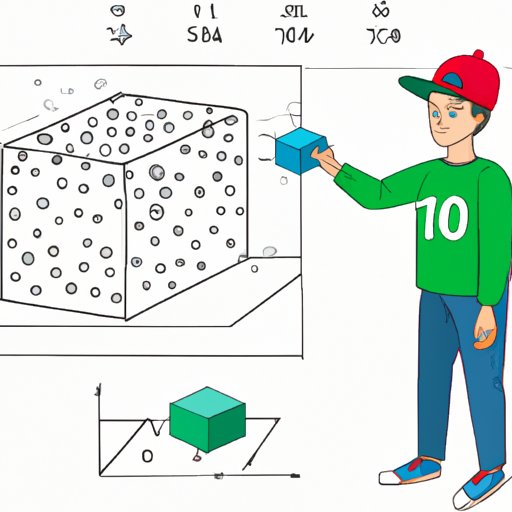
I. Introduction
Proportions can be challenging to solve because they involve finding the relationship between different quantities in a mathematical equation. Understanding how to set up and solve proportions is key in many different fields, from cooking and home renovations to financial calculations and scientific research. In this article, we will explore how to solve proportions step-by-step through the use of real-life scenarios, visual aids, and effective problem-solving strategies.
II. Using Real-Life Scenarios
One effective approach to learning how to solve proportions is to use real-life scenarios. For instance, cooking recipes often require you to adjust the quantity of ingredients based on the number of servings you need. Similarly, financial calculations often involve calculating percentages or ratios. These scenarios can be used to set up and solve proportions by identifying the relationship between the different quantities involved.
Consider the following example: a recipe calls for two cups of flour and three cups of water to make five servings of soup. If you only need to make three servings, how much flour and water should you use? The proportion can be set up as follows: 2/5 = x/3. Once you solve for x, you can determine how much flour and water you need for three servings.
III. Visual Aids
Visual aids are helpful tools for clarifying the concept of proportions. Diagrams, images, and infographics can be especially useful in illustrating proportion problems. For example, cross-multiplication can be more easily understood by using a diagram. Cross-multiplication involves multiplying the numerator of one ratio by the denominator of the other, and then setting the products equal to each other.
Consider the proportion 2/5 = x/3 from the previous example. To set up this proportion using cross-multiplication, you would multiply 2 by 3 and 5 by x, resulting in 6 = 5x. You can then solve for x by dividing 6 by 5, which gives 1.2. This means you need 1.2 cups of flour and 1.8 cups of water to make three servings of soup.
IV. Step-by-Step Guide
Solving proportions can be broken down into clear, simple steps. Here is a step-by-step guide:
- Identify the given quantities and the unknown quantity.
- Set up the proportion, with the unknown quantity represented by the variable.
- Cross-multiply the two ratios.
- Solve for the unknown variable.
- Check the answer by plugging it back into the original proportion.
Consider the following example:
A recipe calls for 1 cup of milk and 2 cups of flour to make 8 servings of pancakes. How much milk and flour do you need to make 4 servings?
- The given quantities are 1 cup of milk, 2 cups of flour, and 8 servings. The unknown quantity is how much milk and flour you need to make 4 servings.
- Set up the proportion: 1/2 = x/4
- Cross-multiply: 1 x 4 = 2x
- Solve for x: 4/2 = x, which simplifies to x = 2.
- Check the answer: 1/2 = 2/4 is a true statement.
When dealing with varying units of measurement, such as metric and imperial units, it’s important to use consistent units throughout the problem. You can convert between units of measurement using conversion factors. For example, 1 inch = 2.54 centimeters, so to convert 5 inches to centimeters, you could multiply 5 by 2.54 to get 12.7 centimeters.
V. Common Mistakes and How to Avoid Them
Common mistakes when solving proportions include forgetting to cross-multiply, incorrectly setting up the proportion, and making arithmetic errors. To avoid these mistakes, it’s important to check your work and approach problems systematically. You can also try solving the problem using an alternative method to check your answer.
VI. Interactive Quiz
An interactive quiz can be a useful way to test your knowledge of proportions and further cement your understanding of the topic. Here are some sample questions:
- What is the relationship between the numerator and denominator in a proportion?
- True or false: To solve a proportion, you must cross-multiply the two ratios.
- Which of the following is a correct proportion? a) 2/4 = 3/10 b) 5/7 = 15/21 c) 6/4 = 10/15
VII. Video Tutorial
A video tutorial can be helpful for those who prefer a visual explanation of proportions. Here’s an example of how to solve a proportion step-by-step:
In this example, we are given a proportion: 2/5 = x/3. We need to solve for x. Here are the steps:
- Cross-multiply the two ratios: 2 x 3 = 5x
- Solve for x: 6 = 5x, so x = 6/5 or 1.2
- Check the answer: 2/5 = 1.2/3 is a true statement.
VIII. Conclusion
Solving proportions can seem daunting at first, but by using real-life scenarios, visual aids, and effective problem-solving strategies, you can master this topic. Remember to approach problems systematically and check your work to avoid common mistakes. With practice, you’ll be able to solve proportions with ease and apply this skill to various fields and scenarios.





